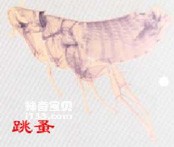Although the body of a flea is only as big as a sesame seed, it sucks blood very ferociously. Blood-sucking is the only way for adult fleas to absorb nutrients. Only by sucking enough blood can fleas mate and produce offspring. Different types of fleas have different times and amounts of blood sucking in a day. One type of flea sucks up to 13-17 ml of blood in 24 hours, which is 20-30 times more than its body weight. It can be called a vampire. . Since a variety of pathogens can be preserved and reproduced in fleas, they not only cause harm to people through bites and blood-sucking, but more importantly, the diseases they spread. Plague is an acute infectious disease with extremely high mortality rate. In the 14th century, the plague (the famous "Black Death") was prevalent in Europe. At least 25 million people died from the plague, accounting for about a quarter of the European population. During the plague epidemic in 1792-93 during the Qianlong reign of the Qing Dynasty in my country, a poem once wrote: "A rat dies in the east, a rat dies in the west. When a person sees a dead rat, it is like seeing a tiger." A rat dies within a few days, and a human dies like a brick. People die during the day, don’t ask how many people died in the day. The sun is bleak and misty. Three people walked less than ten steps when two people suddenly died crossing the road..."The above facts fully demonstrate that insect-borne diseases are more harmful to humans than tigers. A hundred times more powerful.

Plague is caused by a small bacillus called Yersinia pestis. This bacterium is transmitted to humans through fleas on rats (rat fleas). After the fleas sucked the blood of plague victims, their stomachs became filled with plague bacilli, and their esophagus became blocked by the bacteria. Although they are rat fleas, they sometimes bite humans. When this kind of bacterium-carrying flea inhales blood, the blood flows back from the mouth into the body of the bitten person because the esophagus is blocked by bacteria and cannot enter the stomach. At this time, plague bacteria enter the human body along with it, causing the person to suffer from plague. When fleas feed on human blood, they may also excrete feces on human skin, which may also contain large amounts of plague bacteria. Because the bitten area is itchy, itching can bring plague bacteria into tiny wounds, which can also make people infected with plague.
Fleas are extremely small and have many bristles that grow upside down to help them move within the hair of their host animals. It also has two strong hind legs, so it is good at jumping and can jump seven or eight inches high. The female lays her eggs in dusty corners, small holes in walls and floors, or on animals, and they fall to the ground or migrate as the animals move. The eggs are white, and white, legless larvae hatch out in about four or five days. The larvae feed on organic matter in the dust and flea feces. Two weeks later, the larvae spin silk and dust to form a cocoon and pupate in it. After another two weeks, the flea emerges from the cocoon. If a flea comes into contact with an animal, it will immediately cause harm by sucking blood. To eliminate fleas, you need to fill holes in walls and floors with lime or mud, and clean them frequently to keep them dry and hygienic. They can also be sprayed with insecticides to get rid of them.
animal tags:
We created this article in conjunction with AI technology, then made sure it was fact-checked and edited by a Animals Top editor.